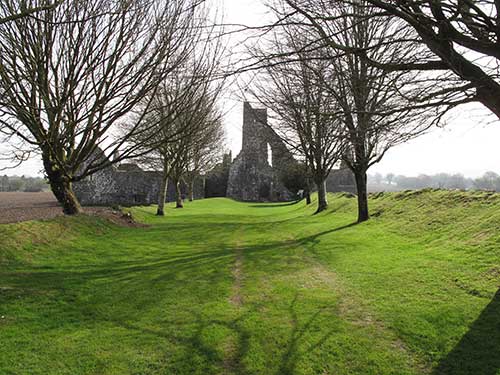
Module 2: The spread of the ‘new’ orders and their interface with local patrons
Dr Małgorzata Kradnodębska -D’Aughton (AI) is working with Dr Annejulie Lafaye (PD) on this module. Primary source research and initial site field surveys have been undertaken concentrating on settlement clusters in Leinster (Drogheda, Co. Louth, Kildare, Naas, Athy and Castledermot, all Co. Kildare) and Munster (Kilcrea, Timoleague (both Co. Cork) and Waterford).
For Leinster, desk-based research to establish the development of each of the settlements has now been completed. This has a particular focus on the thirteenth-century establishment of the orders in these towns, and the relationship of the religious houses to other significant medieval structures, in particular patrons’ castles. It has also sought to establish other relationships with the towns’ morphologies, such as proximity to town walls/ gates/ bridges etc. Plans of the medieval towns have been generated and initial detailed site visits made, primarily with the aim of identifying potential locations for geophysical survey, and the extent of standing remains that might lend themselves to more detailed fabric survey.
From this work, an initial case study, with a particular focus on Dominican foundations in Leinster and the relationship of their establishment to social control has been completed and submitted for publication.
For Munster, two rural sites (Kilcrea and Timoleague) and one urban site (Waterford) have been selected. Initial site survey and field work has identified Kilcrea as an ideal site for geophysical survey. It is envisaged that this will help to establish the relationship of the Franciscan Friary and adjacent tower house, in particular the nature (if any) of settlement between the two structures. Results of this survey will also inform the module 3 study of the changes wrought to the friary and surroundings during the period around and following the Munster Plantation.
Research and site work at Timoleague has focused on the relationship of the friary to the town and its patrons. The complex sequence of building evident on initial analysis of the structure makes it a particularly good candidate for a more comprehensive digital survey, should time and funds allow.
The development of Waterford relative to its monastic houses forms part of both this and module 3. Work as part of this module has so far focused on an in depth study of the fabric of the Franciscan friary in the town. The survival of primary source documents relating to the foundation have yielded particularly useful results. Working with an archival record of the medieval burials in the friary, a detailed study of the medieval spatial division of the building is nearing completion, and has revealed much about the social and gender divisions evident in burial practices of the period. It is also providing some evidence of the division of liturgical space in the friary. Work has also commenced on a study, for comparative purposes, of similar records surviving for Athenry friary, Co. Galway.

